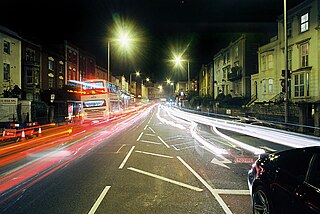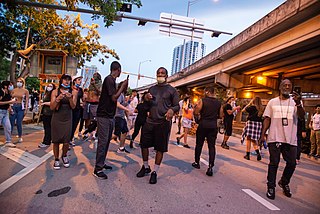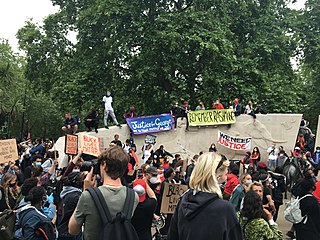
Hartcliffe is the name of both a council ward and an Outer Suburb of the city of Bristol in the United Kingdom which lies within that ward. The ward contains the areas of Hartcliffe and Headley Park, as well as small portions of Withywood and Bishopsworth.
St Pauls is an inner suburb of Bristol, England, situated just northeast of the city centre and west of the M32. It is bounded by the A38, the B4051, the A4032 and the A4044, although the River Frome was traditionally the eastern boundary before A4032 was constructed. St Pauls was laid out in the early 18th century as one of Bristol's first suburbs.

Stokes Croft is a road in Bristol, England. It is part of the A38, a main road north of the city centre. Locals refer to the area around the road by the same name.
Events from 2011 in England

The George Floyd protests were a series of both peaceful protests and riots against police brutality and racism that began in Minneapolis on May 26, 2020, and largely took place during 2020. The civil unrest and protests began as part of international reactions to the murder of George Floyd, a 46-year-old African American man who was murdered during an arrest after Derek Chauvin, a Minneapolis Police Department officer, knelt on Floyd's neck for 9 minutes and 29 seconds as three other officers looked on and prevented passers-by from intervening. Chauvin and the other three officers involved were later arrested. In April 2021, Chauvin was found guilty of second-degree unintentional murder, third-degree murder, and second-degree manslaughter. Chauvin was sentenced to 22.5 years in prison with possibility of supervised release after 15 years for second-degree murder in June 2021.
Starting in May 2020, demonstrations over the police murder of George Floyd were held in the city of Portland, Oregon, concurrent with protests in other cities in the United States and around the world. By July 2020, many of the protests, which had been held every day since May 28, drew more than 1,000 participants. Protests continued into August, September, and October 2020, often drawing hundreds.

There have been a series of George Floyd protests in Virginia. Following the murder of George Floyd by a police officer, protests spread from Minneapolis to other parts of the United States, including Virginia. Protests broke out in Richmond on the night of May 28 and spread to over 50 other cities over the following days.

Washington, D.C., the capital of the United States, experienced a series of protests and riots following the murder of George Floyd in Minneapolis. Some of the events involved violence, looting, and destruction.

This is a list of protests in Florida in response to the murder of George Floyd. On May 31, 2020, Florida Governor Ron DeSantis activated the Florida National Guard, and deployed 700 soldiers to assist law enforcement agencies across the state. Additionally, DeSantis instructed the Florida Highway Patrol to mobilize 1,300 troopers to assist in policing actions.

This is a list of protests held in Wisconsin, related to the murder of George Floyd, during 2020. Additional protests occurred in late August in Kenosha, Wisconsin in the aftermath of the shooting of Jacob Blake and Alvin Cole.

Protests were held across the United Kingdom following the murder of George Floyd, a 46-year-old African-American man, by police officers while under arrest in the United States on 25 May 2020. Immediately following his murder, protests and riots occurred in dozens of cities across the United States. Protests were staged internationally for the first time on 28 May, with a solidarity demonstration outside the United States Embassy in London. They took place during the UK COVID-19 pandemic.

The murder of George Floyd on May 25, 2020 triggered a wave of protests throughout Tennessee in late May and early June 2020.

Local protests over the murder of George Floyd began on May 26, 2020, and quickly inspired a global protest movement against police brutality and racial inequality. The initial events were a reaction to a video filmed the day before and circulated widely in the media of police officer Derek Chauvin kneeling on Floyd's neck for 9 minutes and 29 seconds while Floyd struggled to breathe, begged for help, lost consciousness, and died. Public outrage over the content of the video gave way to widespread civil disorder in Minneapolis, Saint Paul, and other cities in the Minneapolis–Saint Paul metropolitan area in the five-day period of May 26 to 30 after Floyd's murder.

Deona Marie Knajdek, a 31-year old American woman, was killed on June 13, 2021, when a man drove a car into a crowd of demonstrators who had gathered as a part of the Uptown Minneapolis unrest. That evening, demonstrators protesting the law enforcement killing of Winston Boogie Smith had blocked the intersection of West Lake Street and Girard Avenue. At approximately 11:39 p.m. CDT, a man in a late-model Jeep Cherokee drove into the crowd at a high speed, striking a parked vehicle that had been used to block off the intersection to traffic, which then collided with protesters, killing Knajdek and injuring three others.

A wave of civil unrest in the United States, initially triggered by the murder of George Floyd during his arrest by Minneapolis police officers on May 25, 2020, led to riots and protests against systemic racism in the United States, such as in the form of police violence and other forms of violence. Since then, numerous other incidents of police brutality have drawn continued attention and unrest in various parts of the country.

False rumors of a police shooting resulted in rioting, arson, and looting in the U.S. city of Minneapolis from August 26–28, 2020. The events began as a reaction to the suicide of Eddie Sole Jr., a 38-year old black man who was being pursued by Minneapolis police officers for his alleged involvement in a homicide. At approximately 2 p.m. on August 26, Sole died after he shot himself in the head as officers approached to arrest him. False rumors quickly spread on social media that Minneapolis police officers had fatally shot Sole. To quell unrest, Minneapolis police released closed-circuit television surveillance footage that captured Sole's suicide, which was later confirmed by a Hennepin County Medical Examiner's autopsy report.













